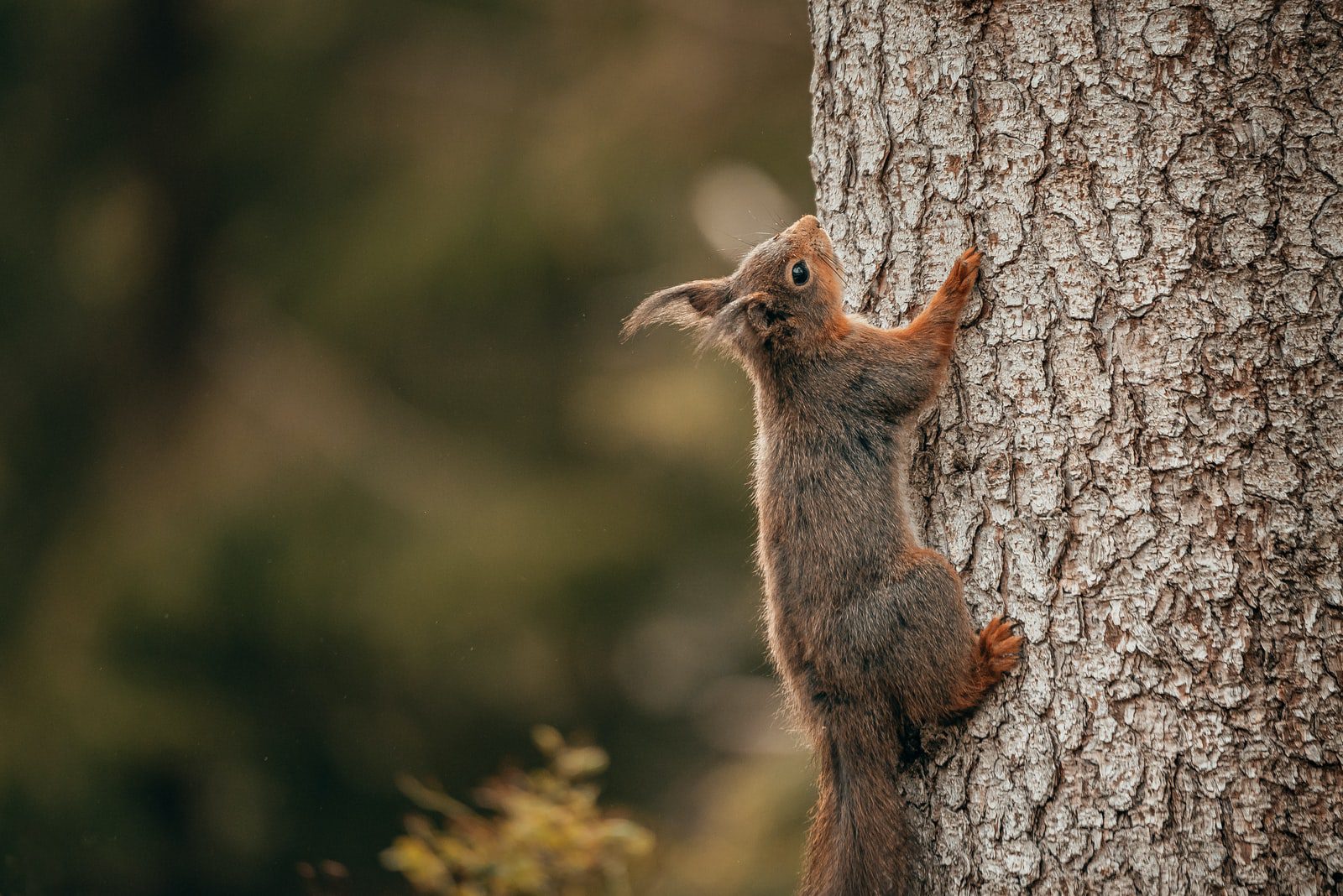Taking your dog for walks can be a relaxing way to enjoy the outdoors and exercise. However, a casual paced stroll through your neighborhood could turn into an intense high-speed pursuit the second a squirrel enters the picture.
These clever critters show up now and then and can make even the tamest of pups go wild.
Owners often feel helpless once their dog’s adrenaline kicks in, and they enter hunting mode. They have only a split second to decide if they should let go of their leash, or if they’d rather be dragged along for the ride.
If you’re fed up with becoming an unwilling accomplice in your dog’s pursuits, you will have to learn to control them. This guide can teach you how to react appropriately and manage your dog’s behavior whenever they spot a squirrel.
So let’s start by looking at why do dogs chase squirrels in the first place.

Why Do Dogs Like to Chase Squirrels?
You don’t have to be a dog whisperer to notice that most canines despise squirrels with a passion. They can make the calmest of canines enter a frenzied fit that lasts for ages, even after the offender has left their line of sight. So why does this happen?
There are several reasons why do dogs chase squirrels, but the two most common ones are the following.
According to experts, most of this behavior comes down to your pup’s innate hunting tendencies. Dogs may have descended from wolves thousands of years ago, but they have still retained their primal drive to hunt.
As much as Rex enjoys chowing down on a bowl of kibble, nothing excites him as much as the thrill of pursuing prey in the wild. Your local inner-city park is his hunting ground, and squirrels are his prey of choice.
However, the intensity of this hunting drive varies from dog to dog. Some breeds seem to get a kick out of chasing prey, while others are less inclined to bolt after small animals for merely hanging around the area.
This “prey drive” is driven by many factors, and can be broken down into five stages:
- The search
- The stalk
- The chase
- The grab
- The kill
Many breeds possess characteristics that enable them to excel in certain hunting stages.
For example, scent hounds such as beagles are adept at searching for prey using their keen sense of smell. Similarly, Australian Shepherds possess stalking instincts and excel at rounding up animals. Terriers, on the other hand, have powerful jaws that enable them to perform swift “kill bites.”
If your dog belongs to a breed with a heightened prey drive, they may spend a significant amount of time pursuing squirrels. Often, dogs will continue searching for squirrels long after they have vanished. This is because the scent of these animals is still lingering in the air and exciting them.
Squirrels are also seen as attractive prey for dogs. They are quick, bushy-looking, and small enough to pursue without fear of retaliation. In addition to these traits, squirrels are also incredibly common in most parts of the country.
Squirrels were artificially introduced to urban city parks in the 19th century, and have grown in number over the decades. It’s not uncommon to see squirrels in most inner-city parks and suburban neighborhoods across the country.
These animals are also challenging for dogs to catch thanks to their swift speed and nimble movements. Your dog may feel annoyed when they fail to catch one after a lengthy pursuit. As a result, they could carry their frustration over to their next encounter with a squirrel.
Your dog’s rivalry with this species may continue to grow over time, so owners need to address their behavior before getting too out of hand.
Watch the following video where a German Shepherd is chasing a squirrel.
Is It Bad for My Dog to Chase Squirrels?
There’s nothing inherently wrong with your dog chasing squirrels. It’s an activity that helps them stretch their legs and get some cardio exercise. It also allows them to let loose and express their natural tendencies in an open outdoor environment.
Despite their strong prey drive, certain dogs enjoy playing with squirrels and have no intention of harming them. However, as mentioned earlier, some dogs with strong “kill” drives might attack the creatures if they manage to catch them.
Owners with large dogs often suffer leash burns and fall when their leashed pooch breaks into a sprint after spotting a squirrel. If your dog is smaller and more manageable in size, they may not be able to pull you against your will, but they will spend a fair amount of time tugging their leash and yapping in the general direction of the critter.
Some dogs get so caught up in pursuing these animals that they forget about their surroundings. It’s not uncommon for dogs to run onto busy roads while chasing other animals and wind up in danger.
This habit of chasing other animals may get worse over time, so it should be discouraged from an early age. If your dog gets too accustomed to chasing small animals, they might turn their attention toward other pets in your neighborhood.

How to Get Your Dog to Avoid Chasing Squirrels?
Now that you know why do dogs chase squirrels, let us discuss how you can stop this behavior. There are many ways to stop your dog from chasing squirrels. These include the following seven methods to stop your dog from chasing squirrels.
If you suspect your dog’s prey drive is being driven by excess energy coupled with sedentary home life, you should get involved with agility sports. If your dog is a greyhound or any other “chase” driven breed, they will enjoy running through obstacle courses regularly. This provides them with a healthy outlet for their energy and reduces some of their urges to chase animals.
If you don’t want to enroll your dog in sports, you can help them expend energy by playing with them at home before going outside. Playing fetch or chasing toys can reduce their prey drive temporarily, and get them to behave calmly in front of other critters.
However, other dogs may need special obedience training if their prey drive isn’t curbed through exercise.
If you can’t get your dog to express their hunting desires through other activities, you will need to train them to be obedient. These training exercises should be performed at home and without a leash. Remember that your goal is to get your dog to behave and obey commands without having to restrain them.
This obedience training should be performed with the three Ds of dog training in mind. These are:
- Distance
- Duration
- Distractions
Your dog’s first few obedience lessons should be carried out in an environment with little to no distractions. You should be standing close to them while giving them easy commands such as “sit” and “stay.” These commands should also last a short duration so that your dog is comfortable withholding them.
When your dog has successfully followed a command for the right duration, you should reward them with a treat. This treat should be given to your dog when they are in the position you want to reinforce.
If you give your dog treats as soon as they stop holding their position, they may get into the habit of following commands for shorter durations so that they receive their treat sooner.
After some time, you should be able to give your dog commands while standing farther away from them. This tests if they are obeying you when you aren’t within reaching distance.
You should gradually increase one “D” at a time during their training sessions and aim to leave “distractions” for the later ones. Once you’re confident that your pup will obey your commands, you can start training them in an environment with more distractions.
For this training, you should pick an enclosed location such as a backyard with a few environmental distractions such as squirrels or birds nearby. Start by standing close to them during your first few sessions and try to keep their attention focused on you whenever a distraction passes by.
As with the earlier exercises, you should gradually increase the distance between you and your dog while ensuring they aren’t pursuing distractions in the environment. Over time your dog will learn to obey you and will think twice before pursuing any critter in the park without your consent.
Keep in mind that this obedience training works best for younger dogs. Canines are capable of learning commands when they are as young as 7 or 8 weeks. But older pups who are set in their ways may have a harder time learning commands.
The saying “you can’t teach an old dog new tricks” rings somewhat true, but you may be able to make some progress with older dogs with enough perseverance and effort.
If you do not want your dog to chase small animals in the vicinity, you will need to keep them on a lease when they are outdoors. However, some collars may hurt your dog’s neck if they have a habit of tugging on their leash.
Dog harnesses are more comfortable for dogs that tend to pull away from their owners. These harnesses also make it easier to control larger dogs, and they also put less stress on your arms and back compared to leashes.
Dogs with high prey drives should be kept on a leash around small animals. These dogs may appear to be well behaved most of the time, but they can attack smaller animals in the absence of their owners. These dogs should also be monitored when small children are around.
Even if your dog doesn’t have a strong “kill” instinct, they could get overexcited while playfully chasing kids around and accidentally hurt them.
If your dog is too large or strong to be controlled, you may have difficulty stopping them from catching prey. Every time your dog successfully catches an animal, they will find it easier to repeat such acts in the future.
Owners need to stop this behavior as soon as possible or risk other family pets or children falling victim to their urges. If your dog has a proven history of attacking other creatures, you will need to keep them muzzled when they are around others.
Owners may be able to interrupt the different stages of their dog’s prey drive by distracting or scaring them by shaking a can filled with coins or blowing an air horn. This strategy works best when your dog has just spotted a squirrel and is getting ready to sprint towards it.
Setting off a loud noise can distract your dog from their prey and refocuses their attention on you. However, this practice should be used sparingly as dogs may start to distrust their owners or develop hearing sensitivity if such tactics are used regularly.
Many owners prefer to use the positive reinforcement approach that is used in obedience training. In this approach, your dog is given a treat if they behave themselves around other animals.
If your obedience training isn’t working, you may have to seek help from a professional. Dog trainers usually have experience training canines from different breeds and getting them to obey commands. They are a great option for busy owners who do not have enough free time to properly train their dogs.
These trainers usually assess your pooch’s unique temperament, personality, and history, before using a suitable approach to train them.
Watch the following video on how to stop your dog from chasing squirrels.

How Does a Dog’s Prey Drive Differ From Aggression?
People sometimes mistake their dog’s prey drive for aggression. However, these behaviors are distinctly different from one another.
Aggression can be defined as behavior that occurs due to self-preservation instincts. If your dog feels threatened by another person or animal, they will either freeze or flee from the situation.
However, if these options aren’t viable for your dog, they may have no choice but to attack whatever is threatening them. This usually happens when similar-sized or larger dogs confront them.
Prey drive, on the other hand, is an innate urge to pursue and catch other animals. A dog that is displaying aggression will attempt to increase the distance between them and the other animal, whereas a dog that is being driven by their hunting instinct will try to close this distance.
Is a High Prey Drive of a Dog Always Bad?
Your dog’s prey drive isn’t a bad thing in itself. Some dogs, such as dachshunds, express their drive to hunt in harmless ways, such as trying to “burrow” into mattresses and couches with their little paws. However, if your dog’s habits lean towards more overt hunting behavior, you could help them relieve their urges by using them as proper hunting dogs.
Many owners train their pups to become “squirrel dogs” that professionally hunt squirrels and other small animals. This is a win-win for these canines, as they get to remain as valued family pets while also being allowed to express their natural tendencies in a controlled setting.
However, these dogs will need to be adequately trained before they can be used for hunting. They should follow commands and wait for their owner’s signal before pursuing prey. This is important because untrained dogs that are allowed to hunt freely might not know how to control themselves around family pets.
Conclusion
Owners shouldn’t give away their dogs just for having a high prey drive. As we’ve learned in this guide, a dog’s prey drive is innate and has little to do with emotion-driven aggression. You should be able to keep your dog from chasing squirrels by using the steps mentioned earlier.
Your dog should be given away only if they aren’t responding to professional training, and are actively harming other people or family pets in your home.
It should also be noted that even though certain breeds possess heightened prey drives, the individual prey drive of dogs within a particular breed can vary greatly. So it’s unfair to assume a dog will possess a certain level of hunting drive solely based on its breed.
Now that you have a better understanding of why do dogs chase squirrels, you can manage their behavior in healthy ways. So remember to practice your commands and be ready for next time you and your dog encounter a squirrel at the park.
References
- “How to Tame Prey Drive in a Dog: Michelson Found Animals: Donate.” Found Animals, www.foundanimals.org/control-dogs-predatory-chase-drive/.
- Oelze, Patty. “Why Dogs Chase Squirrels – Wag!” WagWalking, Wag!, 7 Feb. 2018, wagwalking.com/behavior/why-dogs-chase-squirrels.
- “Prey Drive in Dogs: Understanding & Managing: Hill’s Pet.” Hill’s Pet Nutrition, www.hillspet.com/dog-care/behavior-appearance/prey-drive-in-dogs.
- Gibeault, Stephanie. “The Three Ds of Dog Training: Duration, Distance, and Distraction.” American Kennel Club, American Kennel Club, 2 May 2018, www.akc.org/expert-advice/training/dog-training-duration-distance-distraction/.
- Weselby, Cathy. “Does Your Dog Have a Strong Prey Drive? Mine Does — Here’s How I Curbed It.” Dogster, 19 May 2015, www.dogster.com/lifestyle/dog-training-strong-prey-drive.
- Yu, Alexander. “Why Do Dogs Chase Squirrels? (And How To Curb This Behavior!).” Yuna The Labrador, 16 May 2020, www.yunathelab.com/why-do-dogs-chase-squirrels/.







